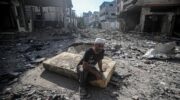A Palestinian woman fills water from a tank near the remains of her house, in Khan Younis, Gaza (Reuters)
By Kathryn Shihadah
The United Nations has often provided valuable reports on the situation in the Palestinian Occupied Territories (although in at least one case the UN removed such a report following pressure from Israel and the United States – see this, this, and this).
The UN’s latest report on the region, “Gaza Ten Years Later,” contains much valuable, factual information. However, parts of the report exhibit a troubling lack of proportionality. This flaw is then maintained in quoted comments on the UN report by National Public Radio journalist Daniel Estrin.
Below is the NPR news story on the UN report, with comments in Italics that discuss some of its statements:
U.N. Says Gaza Is ‘De-Developing’ Even Faster Than Expected, by Merrit Kennedy, NPR
Five years ago, the U.N. warned that Gaza is expected to be unlivable by 2020. A new report now says conditions are deteriorating there even faster than it forecast.
“What needed to happen has not happened, and the indicators are accelerating instead of slowing down,” Robert Piper, the U.N. Coordinator for Humanitarian Aid and Development Activities in the Occupied Palestinian Territory, told NPR’s Daniel Estrin.
“In a nutshell, Gaza continues to de-develop in front of our eyes,” Piper adds. “From health care, to unemployment, to energy, to access to water, across all of these fields, Gaza’s 2 million people are seeing faster and faster decline in their living conditions.”
The population of Gaza, a 130-square-mile strip of land on the Mediterranean, is growing faster than projected, while infrastructure and services haven’t been able to keep up. The population is now forecast to reach 2.2 million people in 2020, up from the 2012 projection of 2.13 million.
The UN report, and the NPR discussion, correctly highlight the rapid pace at which Gaza is moving toward humanitarian disaster. However, as the discourse continues, a moral equivalence fallacy begins to emerge. Daniel lists three sources of Gaza’s trouble:
“Many of the problems stem from the Hamas takeover of Gaza 10 years ago, Israel and Egypt’s blockade of Gaza and the Palestinian Authority’s recent reduction of electricity to Gaza to pressure its rival Hamas,” Daniel reports.
What’s wrong with this picture?
Undoubtedly, Hamas’ feud with the PA is part of the problem; so are the electricity shortage and the closed crossing to Egypt. But placing these factors on par with Israel’s now ten-year-long blockade ignores the facts—some of which are spelled out in the UN report:
Israel retains full control of all movement of people and goods to and from Gaza by sea, air and land, with the exception of a 12 km strip of border with Egypt…Following the expulsion of the PA by Hamas in the summer of 2007, the Israeli Government declared Gaza “hostile territory” and, again citing security concerns, announced a number of new sanctions and restrictions on the access and movement of people and goods, ultimately amounting to a blockade by sea, air and land. Many of the restrictions imposed then, are still in place. (Italics added)
It is worth taking a moment to discuss the question of Hamas, which continues to be a scapegoat for Gaza’s ongoing crisis. Hamas’ complicated rivalry with, and appropriation of power from, Fatah and the PA–and its reputation as a terrorist organization–need to be challenged.
Hamas won a democratic election in Gaza and the West Bank (in spite of the US spending $2.3 million to support Fatah and Israeli obstruction), and was promptly discredited by the US and the EU. Israel commenced sanctions only 3 days after the election. These reactions were nothing short of collective punishment by world superpowers, simply because the “wrong” party won. The charge that Hamas is nothing but a terrorist group, and Palestinians elected Hamas leaders to destroy Israel, shows a profound misunderstanding of Hamas and its rise to power.
Neve Gordon explained in this excellent 2006 article that “the organization’s popularity in the Occupied Territories actually stems from its being seen as the voice of Palestinian dignity and the symbol of the defense of Palestinian rights at a time of unprecedented hardship, humiliation, and despair…In other words, Hamas was elected not only because it is considered an alternative to the corrupt Palestinian Authority, but also because Israel created the conditions that made it an indispensable social movement.”
Back to the de-development of Gaza. In his discussion of the Gaza crisis, Daniel also neglects to mention the three assaults by Israel in 2008, 2012, and 2014. The UN report does mention them, but the description is problematic:
In addition to the impact of the violent Hamas takeover and ensuing Israeli measures imposed in 2007, three rounds of armed hostilities between Israel and Hamas – with the most devastating round in 2014 – have dealt repeated blows to the Gazan economy and damaged essential infrastructure.
These words may be technically accurate: yes, Hamas took over Gaza amid violence; yes, Israel imposed “measures” in 2007; yes, there have been three rounds of “armed hostilities”—but the statement is egregiously inequitable. It is absurd to suggest that the Hamas takeover was equally as damaging to Gaza as the three deadly assaults by Israel were. And the portrayal of the hostilities as though between two equal, evenly-matched armies when Israel has the latest weaponry and Gaza is essentially unarmed, is patently false. Here is a more precise description of the lopsided outcome of the hostilities, found further along in the UN report:
The first major round of hostilities broke out on 27 December 2008 and lasted for more than three weeks. During this time, nearly 1,400 Palestinians and 13 Israelis18 were killed and some 60,000 homes were damaged or destroyed…The second major escalation of hostilities began on 14 November 2012 and lasted for one week, in which 174 Palestinians, including 107 civilians, and six Israelis, of which three were civilians, were killed, and some 10,000 homes damaged. The latest, and most devastating round of hostilities, took place between 8 July and 26 August 2014. During these 51 days, 2,251 Palestinians, including at least 146 civilians, and 71 Israelis, of whom five were civilians, were killed, and 171,000 homes were damaged.
The death toll after three “rounds of hostilities” was 3,825 Palestinians and 90 Israelis. The total number of homes damaged was 241,000—all Palestinian. In addition, schools, hospitals, and power plants were decimated. This is not a description of the aftermath of “war,” but of blitzkrieg.
The NPR story goes on to mention in passing Israel’s regulation of the border—without acknowledging the seriousness of the closure and how it affects any attempts at reconstruction. He even equates Israel’s meddling with Egyptian actions, although Egypt shares only a 7-mile border vs. Israel’s which is 32 miles long and a much greater object of hostility. Here is the statement:
Israel maintains tight control over the movement of people and goods from all sides of Gaza, aside from the 7-mile-long border Gaza shares with Egypt, which is rarely open.
The UN report describes more fully the impact the closure is having on efforts to rebuild over the last three years. This is not just “tight control”—it is crippling restriction on building materials and other critical supplies:
[Restrictions] imposed on the Strip continue to significantly impact the daily lives of Gaza’s inhabitants and the efforts of the international community to implement humanitarian and development projects. Israel considers many materials needed for these projects to be ‘dual-use’ and posing security concerns, thus subjecting them to severe import restrictions. These include construction materials, raw material for the productive sectors, including wood and pesticides, medical equipment and water pumps necessary to deal with seasonal flooding.
It is worth noting that Israeli limitation of imports included (in 2010, and is mostly still in place) wood for construction, cement, iron, tarps (for roofs on huts), fishing rods, farm animals, many spare parts for farming equipment, notebooks, pens, pencils, and toys.
The NPR report then moves on to the topic of water:
By the end of 2017, the U.N. projects Gaza’s only water aquifer will be depleted. The damage could be irreversible by 2020 due to salt water entering the aquifer. That would be “catastrophic,” the report says, and the “living and health conditions of the people of Gaza can only further deteriorate, exposing the population to water-borne illnesses, and other threats.”
The U.N. had previously said that the aquifer would be depleted by 2016, earlier than the current projection. Piper says this small piece of positive news is more akin to “re-arranging the deck chairs on the Titanic than really having much to celebrate.”
This is objectively true—although the image of “deck chairs on the Titanic” makes the Gaza situation sound more like a movie trailer than a humanitarian crisis. Let’s add some detail from the UN report to shed light on the reality:
Access to safe drinking water in Gaza through the public water network plummeted [after 2000]…As a result, reliance on water tanks, containers and bottled water rose from 1.4% to 89.6%…Having to rely on water trucking comes at a high cost on consumers, as trucked water is 15-20 times more expensive than water from the network. This particularly impacts the most vulnerable who are often poor and unemployed and do not have access to piped network water. Trucked water is also unregulated and unreliable in terms of quality.
This gives us a clearer picture of not only the expense but also the continued risk posed as the public water network becomes unusable. People of Gaza pay a premium for water that may or may not be safe.
Israel has an obligation to the people of Gaza which should be part of any conversation about the crisis. A number of prominent human rights organizations have determined that whether Gaza is considered occupied, in armed conflict with Israel, or under Israel’s control, international law demands that Israel solve the water crisis.
NPR then moves on to waste water, describing the nightmare scenario that is happening today:
At the same time, the amount of poorly treated sewage dumped into the sea is increasing, now equivalent to 43 Olympic size pools daily. That is expected to increase by almost 10 percent by 2020, which could have “significant environmental consequences,” the report warns.
The U.N. says new water treatment facilities need to be constructed to address the water crisis. However, Israel is limiting imports on many of the materials needed for construction because it says they could be used for military purposes.
Electricity is another critical need in Gaza. The NPR report continues:
And any future new [sewage treatment] plants would require a steady electrical supply, which at the moment is highly uncertain.
In fact, “an 11-year-old child has not experienced more than 12 hours of electricity in a single day in his/her lifetime,” according to the report. It says that in the most pessimistic 2020 estimate, only 25 percent of Gaza’s electricity demand would be met.
The economy of Gaza, its employment figures, and health care provisions are also notable. NPR reports:
The economy in Gaza has significantly declined in the last decade, with per capita GDP decreasing by 5.3 percent between 2006 and 2016. The report describes Gaza’s economic trajectory as “de-development,” even as the occupied West Bank has seen 48.5 percent growth in per capita GDP between 2006 and 2016.
Gaza’s unemployment rate is at more than 40 percent, according to the latest figures. It’s particularly severe for 20-24 year olds, at 60.3 percent, and for women, at 64.4 percent.
The number of doctors, nurses and hospital beds has also not been able to keep pace with the growing population. The report says, “while the population has doubled since 2000, the number of functioning primary health care clinics has decreased from 56 to 49.”
Given these “unacceptable” conditions, Piper acknowledges that for some, Gaza would already be deemed unlivable. “For many of us, we’d say that threshold is well and truly passed,” he said. “How do you manage in these sorts of conditions?”
In the report, Piper states: “It is profoundly unjust and inhuman to put Gaza’s civilians through such an ordeal.” He calls them “the victims of various policies by many different actors.”
When there is a victim, there is also a perpetrator. Gaza’s often goes almost unnamed. We must not forget who it is or rest until the humanitarian crisis is averted.
But at least NPR reported on the humanitarian crisis in Gaza, unlike most other mainstream news organizations, including the New York Times, ABC, CBS, NBC, CNN, MSNBC and Fox News.
Kathryn Shihadah is a staff writer for If Americans Knew.
Our operations are funded solely by generous individuals like you. Your contribution will help us continue shining a light on the Israel/Palestine situation and the U.S. connection.
DONATERELATED:
On 50th Anniversary of Israeli Occupation, Palestinian Opinions Largely Ignored
The Illusion of Balance: NPR’s coverage of Mideast deaths doesn’t match reality





